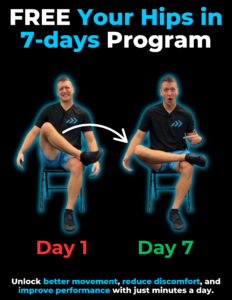Exercises for Upper Trap Muscle Pain Relief
Do you experience nagging discomfort at the base of your neck and shoulder? This is a common sign of upper trap pain, which can also lead to tension headaches and reduced neck mobility. The upper trap muscles often become overactive due to prolonged desk work, poor posture, or repetitive movements, causing tightness and even upper trap trigger points that contribute to pain and stiffness.
In this article, we’ll walk through a proven, four-step approach to fixing upper trap pain using the Functional Mobility Formula. By addressing the root cause—not just stretching—you’ll restore mobility and strength for long-term relief.
If you prefer videos, watch the video version below!
Recognize: Identify the Source of Your Upper Trap Pain
Before jumping into upper trap stretches and exercises, it’s essential to recognize where your symptoms originate. Upper trap pain is typically felt at the corner of the neck and shoulder, sometimes radiating to the base of the skull, contributing to headaches.
To assess your range of motion, try these simple movements:
Tilt your head sideways (ear toward shoulder) and note any tension.
Rotate your head to the left and right, checking for stiffness.
Look up and down to see if any discomfort arises in your upper trap muscles.
If any of these movements cause discomfort, your upper trap muscles may be restricted and need targeted mobility work.
Reduce: Release Tight Upper Trap Muscles
A common mistake people make when dealing with upper trap pain is relying solely on passive stretching. Instead, combining upper trap stretches with active release techniques is far more effective.
Upper Trap Stretch & Isometric Release
Sit on a chair and grab the edge with your affected-side hand.
Lean away slightly to create tension in your upper trap muscles.
Tilt your head away from the tight side and place your opposite hand on your head for a deeper stretch.
Hold for 30-45 seconds.
For added relief, gently push your head into your hand for 7-10 seconds, then relax and deepen the stretch.
Repeat for 2-3 rounds.
This technique helps break up upper trap trigger points and allows for deeper muscle relaxation.
Restore: Improve Neck & Shoulder Mobility
Now that we’ve reduced tension, it’s time to restore movement in the neck and shoulders to prevent upper trap pain from returning.
Chin Tuck & Extension Exercise
Sit tall with your spine aligned.
Perform a gentle chin tuck (bringing your chin toward your throat).
Slowly look up toward the ceiling, feeling a light stretch in your neck.
Repeat 10-15 times, increasing the range as tolerated.
This movement helps restore proper cervical spine mechanics, reducing strain on the upper trap muscles.
Reinforce: Strengthen to Prevent Recurring Pain
Since upper trap muscles are often overactive, strengthening surrounding muscles helps offload tension. The goal is to activate the middle and lower traps for better posture and stability.
Low Bear Hold
Get into a forearm-supported plank position with elbows at a 45-degree angle.
Shrug your shoulders up, then actively pull them down.
Engage your core and lift into a low bear hold (knees slightly off the ground).
Hold for 20-30 seconds or perform 5-6 slow reps.
This drill reinforces shoulder stability, preventing the upper trap muscles from overcompensating.
Bonus: Reassess Your Progress
Now that you’ve gone through the four-step process, it’s important to reassess your mobility and pain levels to measure your progress.
Retest Your Range of Motion
Tilt your head sideways again—does it feel looser?
Rotate your head left and right—is there less restriction?
Look up and down—does the movement feel smoother?
If you’ve noticed improvements, congratulations! You’re on the right track. If not, continue focusing on these exercises for a few more days and reassess again.
Why This Approach Works
By following this structured approach—Recognize, Reduce, Restore, and Reinforce—you address the root cause of upper trap pain rather than just masking symptoms with a quick upper trap stretch. Strengthening and mobilizing the area ensures long-term relief, making daily movements pain-free.
If your upper trap pain has been limiting you, try these exercises today and experience the difference!
Your Next Steps: Neck Mobility 101 Program
To take the next step in relieving upper trap pain and improving neck mobility, check out Neck Mobility 101 in the Mobility Suite App. This program is built on the Functional Mobility Formula, a proven system that delivers fast and lasting relief for neck and shoulder issues.
With Neck Mobility 101, you’ll follow a step-by-step plan that includes targeted upper trap exercises, mobility routines, and strengthening techniques designed to restore optimal neck function. Whether you’re looking to eliminate tension, reduce stiffness, or prevent future flare-ups, this program provides a comprehensive approach to long-term neck health.
Ready to move pain-free? Start your journey today with Mobility Suite!







